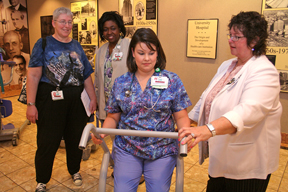Nursing is a physically demanding profession. Push, pull, lift and repeat are as much of a cornerstone of the profession as the Nightingale Pledge.
 |
|
Linda Wallace, far right, a consultant with Diligent Equipment Company, shows Registered Nurse Shae Millwood a piece of equipment that will help nurses better serve their patients in UAB Hospital and protect themselves from injury. |
Tarina Orr, a staff nurse in Spain Rehab, knows the rigors of her occupation. She suffered an injury to her left shoulder and neck while transferring a patient from the stretcher to the bed.
Four of us were transferring the patient, but in the middle of the transfer somebody bumped the bed button and the level of the bed changed,” she says. “When we pulled the patient over I had to lift higher than I anticipated, and that’s how I sustained the injury. At first I didn’t know exactly what happened, but the pain was immediate. I thought I was having a heart attack. It was a burning sensation. You kind of try to shake things off, but it’s not always easy to do.”
Now UAB Hospital’s Safe Patient Handling program will use newly purchased equipment to replace the routine, hazardous task that has required as many as seven or eight caregivers to move patients from a stretcher to the bed or table – and resulted in problems such Orr’s. The results will be less missed work time due to injury, enhanced patient outcomes and improved staff retention, recruitment and satisfaction.
“UAB is doing this because we believe it’s the right thing to do for our patients and our employees,” says Stephanie Burnett, SPH program coordinator. “We have a sicker, aging population and growing obesity in health-care workers and patients. Combine these elements with an aging workforce and that puts health-care workers at risk.”
Survey reveals injuries
In a survey of almost 1,000 UAB health-care workers conducted this past year, more than 20 percent say they have injured themselves on the job. Many said they injured themselves while trying to reposition a patient in the bed or transfer a patient from the bed to a stretcher or table. The most common injuries reported were sustained in the back, shoulders and neck.
“Caregivers have a tendency to sacrifice themselves for the benefit of the patient,” Burnett says. “What they don’t realize is they are putting themselves at risk for injury and possibly sacrificing their livelihood. And they’re doing it every day.”
The risk of injury increases among an aging workforce, and trends suggest workers are extending their careers beyond the traditional retirement age. A 2006 Health Resources and Services Administration report estimated the average age of a registered nurse as 46.8 — more than a year older (45.2) than the estimated average in 2000.
“One of the ways we can accommodate an aging workforce is offering the latest and greatest technology in safe patient-handling services,” Burnett says. “Safety training and ergonomic planning in the environment also are vital.”
Strong commitment
UAB Hospital has committed more than $987,000 to initiate the program and fund equipment, soft goods and clinical support services.
Research from Medscape, a Web site resource for physicians and other health-care professionals, shows that a well-implemented ergonomic plan will positively affect a facility’s bottom line by preventing musculoskeletal injuries, decreasing workers’ compensation costs and retaining nurses and other health-care staff.
“The program will get its money back in a very short period of time by the reduction in on-the-job injuries and medical expenses to employees – both upfront and hidden,” Burnett says. “It’s a significant investment, but it’s a wise investment.”
Cheri Plasters is a registered nurse in Transplant and General Surgical Services and chair of the Professional Nurse Practice Council, a group comprising RN representatives from each unit. She says the group supports the changes.
“Meaningful, appropriate and thought-out practice is the reason we’re going to the Safe Patient Handling program,” she says. “I think it will be very meaningful to all health-care workers that UAB is working to protect its patients and its workforce.”
Up to 4,000 UAB patient-care providers will be trained to use the equipment between September and February 2008 before its use will be mandatory. Training classes will take place in the former critical-care unit on the eighth floor of Spain Wallace from September through February. Employees should talk to their supervisor or educator about the training schedule for their unit.